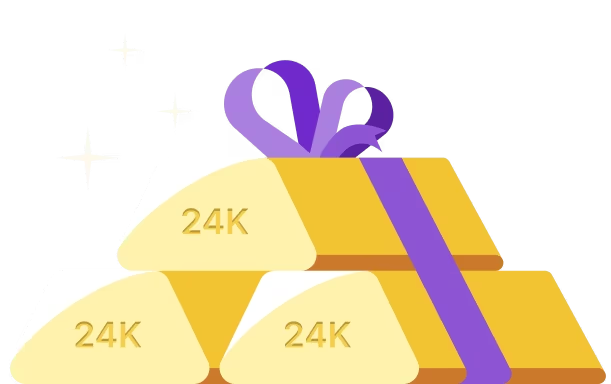As a symbol of wealth and status in India, gold has made its way to every household in the country. During festivals and special occasions like weddings, gold prices witness a surge due to its high demand.
However, it is important to understand the making charges of gold, as it is an essential component of the final price of your gold items. Let us take a look at how these making charges are calculated.
What are gold making charges?
Gold making charges refer to the cost jewellers bear to convert gold into jewellery. Any additional modifications that you request in your jewellery design also fall under the making charge.
The making charges cover the cost of labour and artisans who design your jewellery by moulding gold bricks or bars into intricate shapes. It typically ranges between 3% and 25% depending on the design, price, and weight of the gold ornament.
How are gold-making charges calculated?
It is necessary to understand how gold jewellery making charges are calculated, so that you don’t fall prey to any kind of financial fraud.
Gold making charges are calculated based on the following factors:
1. Cost per gram of gold
In this method, the gold making charges are calculated on the basis of their weightage.
Calculation:
Making Charge = Weight of gold (in gms) x Making charge per gram
2. Percentage-based Making Charges
Under this case, the gold making charges are calculated as a percentage of the total value of gold that you buy. The making charge is directly proportional to the percentage of the gold purchased.
Calculation:
Making Charge = Percentage/100 x Total value of gold
Factors Influencing Making Charges in Gold
1. Quality and Purity
Quality and purity are the first and foremost things that matter when purchasing gold. The making charges for gold chain, ring, bangle, or any other gold jewellery will depend on the quality and purity of the gold.
Here’s all you need to know about the hallmarking of gold.
2. Designing
Designing and crafting a piece of gold jewellery determines the rate of making charges. The more intricate the design, the higher the making charges of gold jewellery.
A piece of plain gold jewellery will more likely be less expensive than studded gold jewellery. Other factors include the purity and weight of the gold used.
3. Transportation Cost
The making charge also includes the handling fee, which includes transportation, packing, and storing the gold jewellery.
4. Weight of the jewellery
The more the weight of gold, the more work it takes to polish. Hence, the higher the making charges for heavy gold. For example, a thick gold chain will have higher making charges than a thin gold chain.
5. Market value
The market value of gold, which is influenced by different seasons, directly affects the making charges for gold jewellery. For example, gold prices soar during Akshaya Tritiya, and so any jewellery bought during this time may have higher making charges than any other off-season time.
6. Brand Value
A larger and more popular brand jeweller may charge higher making fees compared to local jewellers. Big brands invest heavily in superior quality and craftsmanship in their jewellery, which is then transferred to the customer in making charges.
GST on Gold Making Charges
The current rate of GST on gold making charges is 5%, as of May 2025. The 5% GST on gold jewellery making charges is also applicable to the repair process for gold jewellery.
What is the wastage charge?
Similar to making charges, there is also a waste charge applicable to your gold jewellery price. Wastage charge is the cost that covers the loss of small amounts of gold lost during the polishing, cutting, and melting of gold during the jewellery-making process.
The wastage fees commonly range from 5% to 7% of the gold’s weight. If the jewellery design is detailed and intricate, the wastage fee could go higher than 10%.
Difference between Wastage and Making Charges
Making charges refers to the fee levied on the customer for crafting and designing jewellery. It also covers the cost of labour and artisans who design the jewellery.
On the other hand, waste charges refer to the fee levied on the customer for the gold lost during the process of crafting the jewellery.
Oftentimes, tiny portions of gold get wasted during the polishing and cutting process. Jewellers levy wastage charges on the customers to recover the cost of the gold wasted.
- Making charges typically range between 3% and 25% depending on the value of gold.
- Wastage charges range between 5% and 7%.
Find out Tanishq's making charges.
Additional Charges that may be added to the making charges & how to avoid them
- Hallmarking Charges: It is the fees charged by recognised authority to certify the purity of gold.
- Stone-setting charges: These are the charges for setting precious or semi-precious stones in the jewellery.
- Polishing & finishing charges: These are charges to put the final touches and polishing on the jewelry.
In order to avoid such overcharging, keep the following points in mind the next time you buy jewellery:
- A detailed breakdown of all charges, including making charges, hallmarking charges, and any other charges.
- Compare prices across jewellers and do a quick comparison to see how much the additional charges vary and if they are even necessary.
- Negotiate on the additional charges, as most of them can be included in making charges such as polishing, stone setting, etc.
- Ask about the return and exchange policies of the brand.
Frequently Asked Questions (FAQs)
1. How to calculate gold making charges?
There are primarily two methods of calculating making charges. First is the cost per gram method, and the second is the percentage-based method.
2. How to calculate making charges for gold?
Following are the equations for calculating making charges:
- Cost per gram method: Making Charge = Weight of gold (in gms) x Making charge per gram
- Percentage-based method: Making Charge = Percentage/100 x Total value of gold
4. Does gold coin have making charges?
Yes, gold coins have making charges. Although, the gold coins probably levy the lowest making charges compared to gold jewellery.
5. What is the making charges of gold?
Making charges of gold refers to the fee applicable on a gold ornament for its designing and moulding.
6. Is gst applicable on gold making charges?
Yes, a 5% GST on making charges of gold is applicable, as of May 2025.
7. How to buy gold without making charges?
There is no way to avoid making charges on gold jewellery. However, you can purchase gold in the form of digital gold on the Jar app, which will not incur any making charges.
Jar offers 24k digital gold starting from ₹10 without any hidden charges. The amount of money you save is invested in digital gold which is safely secured in a digital locker.
8. Are making charges for gold different in other cities?
Yes, each city’s gold making charges may be different from the other. The making charges differ according to the gold rate, and gold prices vary from city to city.
So, gold making charges in Delhi will be different from making charges of gold in Mumbai. These charges range from 3% to 25%.










